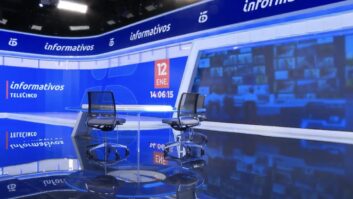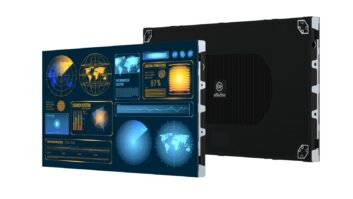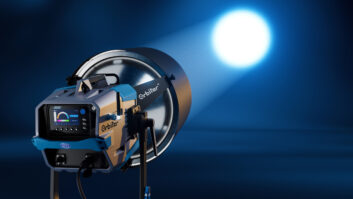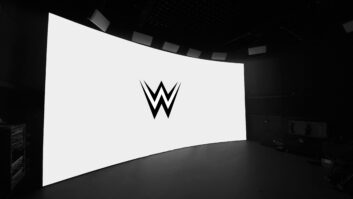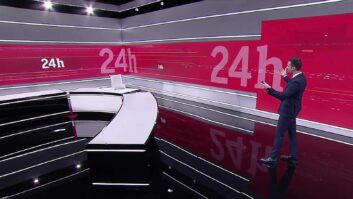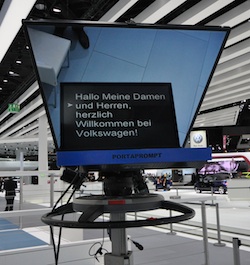
There are two main trends in prompter design: a move to lower-power LED back lighting; and, in tune with the broadcast industry generally, models that are smaller, lighter and cheaper, writes David Fox.
Power consumption and the environment are becoming important considerations for broadcasters, and yesterday’s potentially mercury contaminated Cold Cathode Fluorescent Tube prompters required a lot of power, especially on start up – where they also needed some minutes to reach full brightness. However, LEDs cause no power spikes and even the brightest units use about half the power.
The light spread is also better and blacks are blacker. “The contrast level is absolutely fantastic. Presenters find them easier to read and it causes less fatigue,” said Autoscript’s MD Brian Larter, who has moved his complete range to LED displays. Although the bright, TFT-Plus flat screens are more costly to manufacture, Autoscript has taken a hit on its margins to offer them at the same price as CCFLs. However, the older technology will still be available for customers who want to match new units to old (as LEDs can look a bit odd next to CCFLS).
Portaprompt is also now offering LED versions of all of its existing displays, but not the newly launched ultra bright 24-inch display, as a suitable LED panel wasn’t available in that size (although 24-inch LED displays are available, they weren’t bright enough to cope with the light loss caused by a mirror while still being able to compete with the ambient brightness of studio lights. However, for some other sizes, such as the 15-inch display, the LED and CCFL units have the same brightness (1500 nits).
The 24-inch display is “ideal for large studios,” said Jim Keating, international sales director. “Our previous biggest was 20-inches.” Its first buyer was a German production company, which bought two, and used it initially at the Frankfurt Motor Show.
It does offer standard brightness panels, which are about half as bright as its ultra bright models, at lower prices, as well as the Quasar CCFL and LED units. LED sizes available include: 9-, 10-, 15-, 17-, 20- and 24-inch, all of which run on 12 volts DC and give 36% longer battery life on location.
“LEDs bring a whole wealth of different improvements, not just new features, but added reliability as they can cope with being knocked about, and you get perfect coverage of light,” explained Larter. He has wanted to move to LEDs for some time, but when Autoscript first considered them, three years ago, suitable screens weren’t available. Now its complete range is LED driven (5.6-, 8-, 13-, 15-, 17- and 19-inch displays).
The units will also last a lot longer. “LEDs have eight times the life span of CCFLs. The output of CCFLs diminishes over time and they need replacing. LEDs produce very little heat and that’s a big factor in component failure. There are still fans to regulate heat, but they only come on if it is in a hot studio or outside in the sun.” Autoscript’s LED TFT-Plus is purpose-built in-house rather than using a computer display and includes an illuminated control panel for easy visibility in a dark studio.
There’s an app for that…
Autocue’s new Starter Series is an entry-level product aimed at users that previously couldn’t afford it. It comes in 7-inch, 10-inch and 17-inch versions and is taking on the likes of Prompter People head on, with prices below £1,000.
The units can be floor standing, or fitted below or above the lens, but for location use the most interesting system is also the cheapest. The iPhone Prompter, designed for freelance cameramen, costs just £599, and is similar to the 7-inch Starter pack, but with an adapter plate for an iPhone instead of using Autocue’s display. It comes with a pop up, fully adjustable hood, and a tripod mounting system, and weighs 1.1kg (but you need your own iPhone).
It uses software available from the iPhone App Store, although not written by Autocue, but CEO Frank Hyman promises that it will have its own Autocue App in the near future. Autocue has also launched Mac software for its other Autocue systems, “because this market is 30 to 40% Mac based.”
Autoscript’s new Miniscript portable on-camera TFT monitor, has all the standard connectors of its larger prompter displays, but the 5.6-inch LED panel weighs only 455g, so that it won’t be a burden to move about on location or in the studio.
It includes connections for composite BNC and Hirose power inputs, and was developed with veteran British camera supervisor Phil Piotrowsky, who wanted something more compatible with the increasing use of hand-held cameras for live and studio-based entertainment productions. Being able to fit a lightweight prompter to portable cameras provides a safety net for on-air presenters, who appreciate being able to refer to a prompter as they move freely about the set.
Prompter People’s new Flex 11 prompter is the latest in its budget line. “The Flex 11 is targeted at the education market, where there are strict limits on prices,” explained company president, Mark Ditmanson. The 4.5kg unit will cost Euro999. Unlike its ProLine prompters, the mirror is fixed instead of adjustable. “It’s very simple. 45º is fine for most people, and it all folds up easily for transport.”
Autoscript has introduced a new presenter foot control that is claimed to be the only one specifically designed for the purpose. The new MFC-1 Magno Foot Control uses magnetic, frictionless technology for easier control and increased longevity.
“One of the biggest problems with foot controls is the springs. We wanted to design a foot control that didn’t have a torsional spring [which weakens during repeated pushing]. In the end we found a BMW accelerator which is digital and uses a compression spring,” making it more accurate, more responsive and more robust, said Larter.
“It’s got to be reliable to be used 24 hours a day in newsrooms, so we do sometimes over-engineer things. We also designed it to be used by presenters standing up, which took a lot of work to get the angle right, trialling it with various channels. Some rival products are the wrong angle for standing up and presenters can get cramp,” he explained.
www.autocue-qtv.com
www.autoscript.tv
www.portaprompt.co.uk
www.prompterpeople.eu

